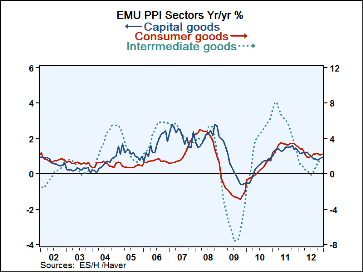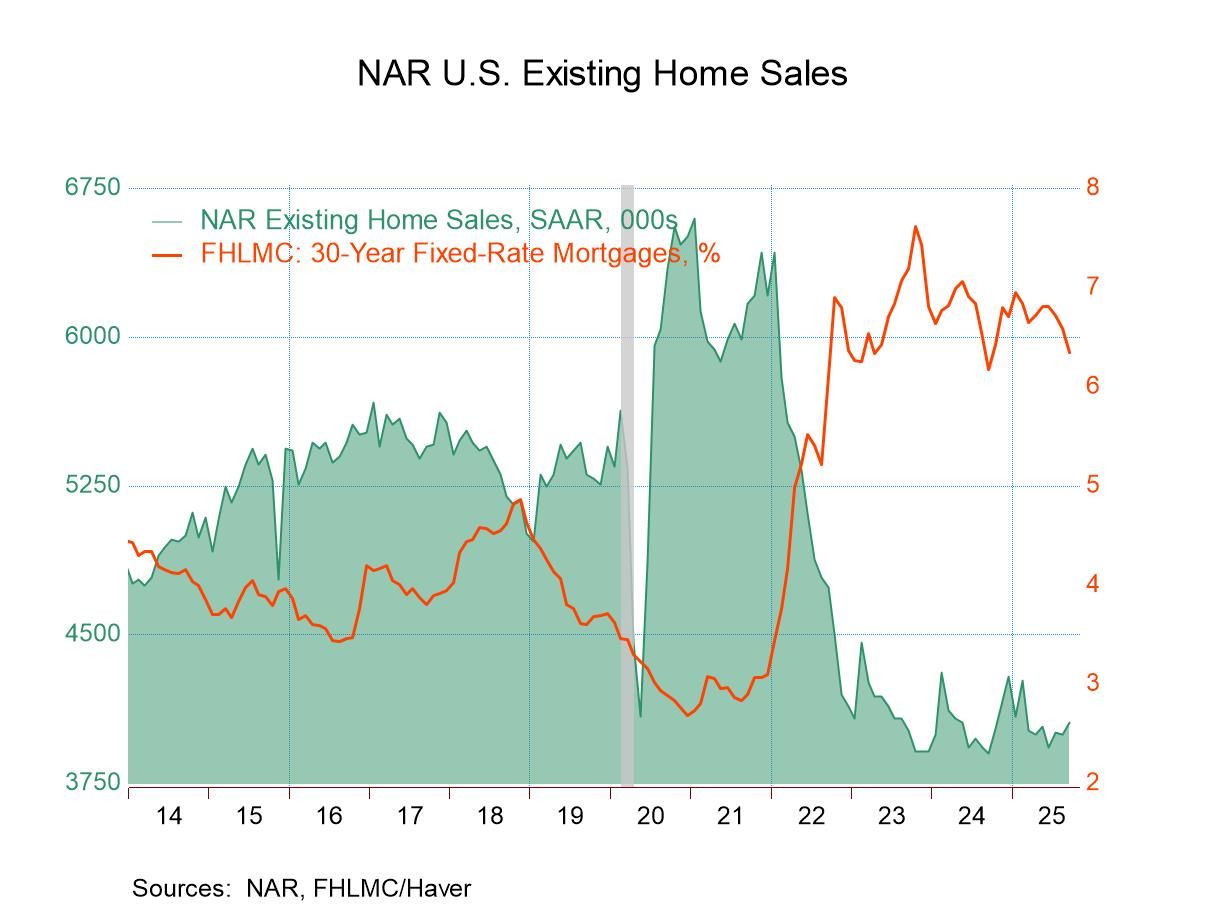 Global| Feb 04 2013
Global| Feb 04 2013EMU PPI Settles Down, Even if EMU Doesn't
Summary
EMU PPI trends appear to be stabilizing on top of the target pace for the HICP. The ECB has not formal target for the PPI. But its 2.1% on muted momentum seems like something the ECB would be pleased with -even its German [...]
 EMU PPI trends appear to be stabilizing on top of the target pace for the HICP. The ECB has not formal target for the PPI. But its 2.1% on muted momentum seems like something the ECB would be pleased with -even its German constituency.
EMU PPI trends appear to be stabilizing on top of the target pace for the HICP. The ECB has not formal target for the PPI. But its 2.1% on muted momentum seems like something the ECB would be pleased with -even its German constituency.
Among the three major categories, capital goods, consumer goods and intermediate goods, only intermediate goods show any sign of persisting inflation.
Even that is something that is not all that worrisome since rising global oil prices could hardly be expected to by-pass any impact on intermediate goods. Still there is no evidence of those cost pressures being passed on. That will be the key.
German and French core inflation show a slight tendency for acceleration but they have even their respective three month annualized rates of inflation below 2%. Italy and UK show no clear inflation trends but their recent annualized three-month path is below 1% in each case.
We can safely conclude that the EBC's biggest problems near terms are not inflation. Still there are concerns about how what the ECB is doing now and how it will play out in the future especially when growth has picked up. But for the moment that concern is only simmering on the back burner.
Europe still has a more clear and present danger from insufficient growth. Spain's unemployment rate is still rising. While Germany and others show less downward pressure, France shows signs of an increased unraveling. The E-zone investor confidence index from Sentix rose in February but its expectations component continued to decline. Things may be 'better' but all is not well.
Europe is doing better, but based on the travails of last year (2012!) that is not saying much. The prognosis may not be for continued unraveling anymore but neither is that path completely off the table. Meandering is on the table and legacy asset problems are very much straining the table and mixed performance is still on the table and mixed performance is what gets EMU/EU/ECB/EcoFin/ETC into trouble.
Good luck with that.
| Ezone and UK PPI Trends | ||||||
|---|---|---|---|---|---|---|
| M/M | SAAR | |||||
| Ezone | Dec-12 | Nov-12 | 3-mo | 6-mo | Yr/Yr | Yr/Yr Yr Ago |
| Total excl. Construction | -0.1% | -0.1% | 0.1% | 3.8% | 2.1% | 4.3% |
| Capital Gds | 0.0% | 0.1% | 0.7% | 0.5% | 0.9% | 1.4% |
| Consumer Gds | 0.1% | 0.1% | 2.3% | 2.9% | 2.2% | 3.1% |
| Intermediate | 0.3% | 0.2% | 3.0% | 2.9% | 1.6% | 2.7% |
| MFG | -0.1% | -0.2% | -0.4% | 3.9% | 1.6% | 3.7% |
| Germany | ||||||
| Excl. Energy | 0.1% | 0.2% | 1.8% | 1.6% | 1.5% | 2.1% |
| France | ||||||
| Excl. Energy | 0.1% | -0.3% | 0.7% | 0.4% | 0.4% | 2.1% |
| Italy | 0.0% | -0.3% | 0.3% | 3.6% | 1.2% | 3.8% |
| UK | 0.1% | -0.2% | 0.6% | 3.8% | 2.2% | 4.8% |
| E-zone Harmonized PPI excl. construction | ||||||
Robert Brusca
AuthorMore in Author Profile »Robert A. Brusca is Chief Economist of Fact and Opinion Economics, a consulting firm he founded in Manhattan. He has been an economist on Wall Street for over 25 years. He has visited central banking and large institutional clients in over 30 countries in his career as an economist. Mr. Brusca was a Divisional Research Chief at the Federal Reserve Bank of NY (Chief of the International Financial markets Division), a Fed Watcher at Irving Trust and Chief Economist at Nikko Securities International. He is widely quoted and appears in various media. Mr. Brusca holds an MA and Ph.D. in economics from Michigan State University and a BA in Economics from the University of Michigan. His research pursues his strong interests in non aligned policy economics as well as international economics. FAO Economics’ research targets investors to assist them in making better investment decisions in stocks, bonds and in a variety of international assets. The company does not manage money and has no conflicts in giving economic advice.






